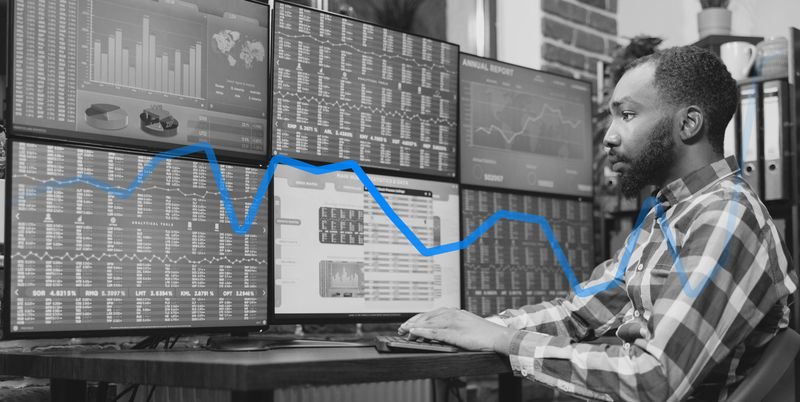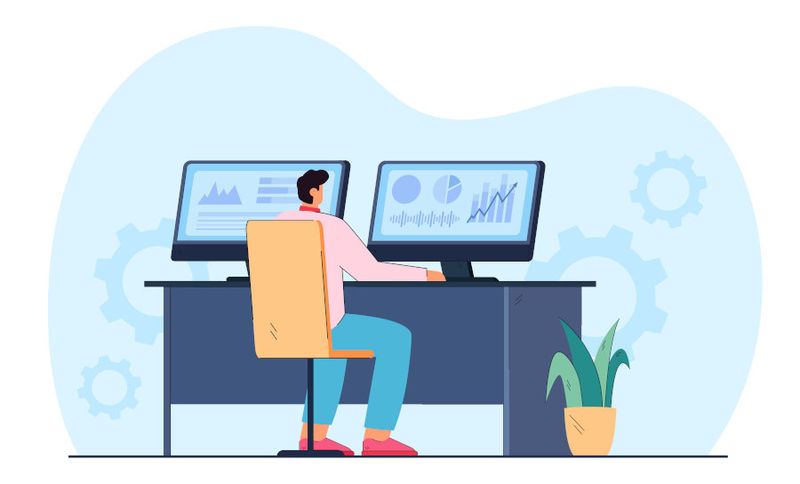Ready to see the market clearly?
Sign up now and make smarter trades today
Education
November 6, 2024
SHARE
How Many Monitors Do Traders Need?
Monitors won’t make the trading decisions but deciding how many are right for you is a surprisingly tricky question. Finding out what works depends on your trading style.
Firstly, let’s cover the obvious: what are the benefits of using more than one screen? Put simply, you can see more information at a glance without needing to switch between windows.
You have the ability to easily watch more markets, as well as monitor news feeds, chat rooms, and so on. Some traders like to see their trading charts over different timeframes, for example one chart with a five-minute timeframe and another at two hours. Others prefer to have a specific indicator or chart always visible so that they can refer to it at any moment.
There is also the added advantage of reducing the strain of your working day, if you, as a trader, are in front of a one screen it can get tiring, especially mentally, to constantly have to switch from one widow to another.
But Do I Really Need More Than One Monitor?
On the other hand, you may ask yourself why can’t I just use one monitor? Well most certainly you can but the answer is qualified with “that depends”. What is your trading timeframe? What information do you need to see to take your decisions? How long are you in front of a screen? In short, what sort of trader are you?
Do you focus on scalping, day trading, swing trading or position trading? Swing traders, for example, typically hold over days or weeks and may mostly modify orders and check positions at the beginning and end of the trading day. Position traders hold for much longer and as a result they do not need to have immediate on-screen analysis, charts, indicators; and so forth.
Scalpers, on the other hand, hold for minutes or seconds and spend much longer in front of a screen and require to-the-micro-second data, meaning that more than one monitor makes sense.
If you are focused on a small timeframe chart, whether as a scalper or day trader, it must be constantly open—switching to another window becomes a distraction that you cannot afford. However, you might also want to refer a higher-timeframe chart, say a one-hour one, so when a position develops well at the smaller timeframe, you can take it to the higher one and let it run longer. Already, the number of screens you are watching is mounting up.
So Why Not Have Just One Big Monitor?
An ultra-wide curved monitor is a thing of beauty for some and traders do use them. The consensus opinion as to their usefulness, however, is mixed.
It’s obviously much less complicated to set up and you don’t have multiple cables nor the mounting brackets for multiple monitors. Users of curved monitors often swear by them and say they make viewing easier.
Others say that the they can get the same effect with three or four smaller monitors and probably at a lower price. Additionally, there is the admittedly rare drawback of what happens if the ultrawide stops working. You have suddenly lost all ability to trade.
Here we come to the subject of having a backup, especially for power outages. You do not want to be stuck on the wrong end of a position, with no way to get out. Unless you go the route of a secondary power source or an uninterruptible power supply (UPS), a backup laptop, tablet or even mobile phone running on batteries is your friend here.
Can I Use Just a Laptop or Phone?
Sure, but again it really depends on how you trade and what you trade. You will definitely need one of them as a backup.
Laptops are fine for most traders, some will need nothing else, others can get by on them at a pinch.
For tablets and phones, the answer is a qualified yes but traders who exclusively use their phones are rare.
They are often used for crypto trading but if you are on small timeframes, say in minutes or less, you should not be using a phone for your trading. Mobile trading apps—and using them—are simply not as fast as desktop software. As timeframes get higher, phones become more useful.
Putting aside the obvious limitations of getting information onto a small screen, and reading it, studies have suggested that traders tend to take more risk when trading on their phones and may overtrade more.
Nevertheless, the flexibility of trading on the go is a big draw.
Don’t Get Overloaded, Start Small
Remember that there is only so much information that a person can process at one time. Do not put your self in the position where you could suffer from analysis paralysis, where you are overwhelmed the information.
When you are beginning, you do not want to be overloaded, either by information or costs.
Unless you have an extremely simple strategy, you will be trading in a simulated or demo environment at first. This means that you have the opportunity to see what works—not only in you trading but also in your physical setup.
Start off small and build up to where you are comfortable.
Image by pch.vector on Freepik

